Дополнительные возможности беспроводного подключения
Обновлённый звуковой набор чипа Snapdragon Sound теперь поддерживает Dynamic Spatial Audio. Под динамическим Qualcomm имеет в виду, что теперь можно перемещать голову в пространстве и слышать, как контент идёт за вами благодаря динамическому отслеживанию положения головы на совместимых наушниках. Эта технология работает с большинством существующих многоканальных пространственных аудиоформатов и декодеров, таких как Dolby Atmos и Sony 360 Reality Audio.
Процессор оснащён встроенным модемом Snapdragon X70, обеспечивающим скорости входящего и исходящего подключений 10 Гбит/с и 3,5 Гбит/с за счёт 4-кратной агрегации несущих частот. Qualcomm говорит, что возможности искусственного интеллекта модема позволяют увеличивать пропускную способность и надёжность подключения как на частотах ниже 6 ГГц, так и на миллиметровых, особенно на границе соты. Более практичной может оказаться поддержка двух активных SIM-карт 5G. С ними можно получать сообщения и интернет-трафик на одну карту и говорить по телефону через вторую.
Хотя новая спецификация ещё не завершена, Qualcomm использует свои внутренние возможности для ранней поддержки стандарта. Здесь обещана скорость передачи данных до 5,8 Гбит/с по каналу 320 МГц в диапазоне 6 ГГц с помощью высокочастотного одновременного многоканального соединения
Задержка будет всего 2 мс, что важно для поддержки облачных игр, XR и других приложений с зависимостью от задержки. Потребуется маршрутизатор Wi-Fi 7, которые пока можно купить только в Китае
User Interface and User Experience

Both the Snapdragon 8 Gen 3 and the Snapdragon 8 Gen 2 provide users with user interfaces and experiences that are virtually identical. Both of these CPUs are able to power high-resolution displays that also have fluid refresh rates, and they support the most recent Android capabilities. In addition, a broad variety of applications and video games can be played on either of these processors.
On the other hand, there are a few significant distinctions between the two processors in terms of the user interface and the experience that it provides. To begin, the Snapdragon 8 Gen 3 has a higher efficiency rating than the Snapdragon 8 Gen 2, which indicates that it will be able to deliver a user experience that is less choppy and more responsive. In addition, the Snapdragon 8 Gen 3 enables ray tracing and can upscale cutscenes to a resolution of up to 8K, all of which can contribute to creating a more immersive gaming experience.
Snapdragon 8 Gen 3 vs Snapdragon 8 Gen 2: Telephones and backside line

Ryan Haines / Android Authority
The Snapdragon 8 Gen 2 powers most of the greatest Android smartphones launched in 2023. We’ve virtually universally praised it on account of its excellent efficiency and effectivity. The Snapdragon 8 Gen 3 seems like a worthy successor in nearly each space. Having mentioned that, we now have some lingering questions on sustained efficiency, given our early check outcomes. In any case, that is an space the place Android SoCs have struggled prior to now.
Qualcomm launched the Snapdragon 8 Gen 3 on October 24, 2023. It didn’t take lengthy for the primary cellphone sporting the chipset to hit the market within the type of the Xiaomi 14 sequence, albeit solely in China for now. The SoC is anticipated to energy many high-end smartphones all through 2024, together with huge names like Samsung’s Galaxy S24 household.
The last-gen Snapdragon 8 Gen 2 is loads able to powering smartphones for years to return.
Concurrently, nevertheless, we don’t anticipate the Snapdragon 8 Gen 2 to vanish simply but. Qualcomm’s previous-gen SoCs have usually made a comeback later of their life cycles in higher mid-range and sub-flagship smartphones. The identical ought to maintain true for this last-gen chip too. And contemplating the quantity of efficiency on supply, it’s undoubtedly an incredible selection even when it’s now not the most effective.
So with that in thoughts, which SoC must you prioritize in your subsequent smartphone? Given the large efficiency uplift, we’d say the Snapdragon 8 Gen 3 does eke out a win vs the Snapdragon 8 Gen 2. Nevertheless, that equation might change barely if you could find deep reductions on a smartphone toting the older SoC.
FAQs
Do the Snapdragon 8 Gen 2 and Snapdragon Gen 3 have ray tracing?
Sure, each the 8 Gen 2 and eight Gen 3 help hardware-based ray tracing. Nevertheless, the 8 Gen 3 provides a 50% efficiency increase, based on Qualcomm.
Are Snapdragon 8 Gen 2 and Gen 3 future proof?
Sure. Each supply loads of efficiency and cutting-edge options like ray-tracing, AI capabilities, and Wi-Fi 7. Being newer, the Snapdragon 8 Gen 3 is probably the most future-proof of the 2.
Do the Snapdragon 8 Gen 2 and Gen 3 have heating points?
Neither chip suffers from widespread overheating points. That mentioned, some smartphone designs are higher at dissipating warmth than others, that means some handsets carry out at increased ranges for longer.
Feedback
PC Mark Performance and Work 3.0 Battery Benchmark
| Performance Score | Work 3.0 Battery | |
|---|---|---|
| iQOO 12 | 14873 | 15h 22 min |
| Honor Magic5 Pro | 14310 | 13h 38 mins |
| Honor Magic4 Pro | 14670 | 10h 32 mins |
| Samsung Galaxy S21 Ultra Exynos 2100 |
13638 | 12h 46min |
| Pixel 8 Pro | 12091 | 12 hours 56 mins |
| OPPO Find X3 Pro | 11932 | 9 hours |
| Pixel 7 Pro Tensor G2 |
11550 | 11h 39min |
| Pixel 6 Tensor |
11443 | 9h 45min |
I find the PC Mark test pointless for chipset comparisons as the result varies widely between phones. It seems that some brands will maintain a high performance throughout, whereas other brands massively reduce the CPU frequencies for certain tasks.
Even the battery results are questionable. I can confidently say that the Honor Magic5 Pro is significantly better for battery life in comparison to the Pixel 8 Pro. I’d guess that I get at least 50% more use from one charge with the Honor.
In this case, there have been negligible improvements in the performance score for three generations of the flagship Qualcomm Snapdragon 8 chipset, but a significant improvement in battery life. The Honor Magic4 Pro only had a 4600 mAh battery, but the Honor Magic5 Pro has a 5100 mAh battery, while the iQOO has 500 mAh. The iQOO also has a fractionally smaller a lower resolution display though a higher refresh rate.
Even though I find these results unreliable, the endurance increases are logical due to the efficiency improvements of the chipset.
Snapdragon 8 Gen 3 vs Snapdragon 8 Gen 2: Gaming performance
When it comes to gaming performance, the Snapdragon 8 Gen 3 has a very minor advantage over the Snapdragon 8 Gen 2. This is because its GPU has a greater maximum clock speed, which also makes it more powerful. In most games, the Snapdragon 8 Gen 3 has a better performance than the Snapdragon 8 Gen 2, according to benchmark tests. The Snapdragon 8 Gen 3 achieves a score of 44.5 frames per second in the 3DMark Wild Life Extreme benchmark, whereas the Snapdragon 8 Gen 2 achieves a score of 40.8 frames per second.
When put to action in the real world, the Qualcomm Snapdragon 8 Gen 3 is capable of running games at better frame rates and with more advanced settings than its predecessor, the Qualcomm Snapdragon 8 Gen 2. This is especially the case for resource-intensive mobile games like Fortnite and Call of Duty: Mobile. It is essential to take into account, however, that the difference in gaming performance between the Snapdragon 8 Gen 3 and the Snapdragon 8 Gen 2 is not particularly significant. Both chips are able to handle games that are extremely demanding in their requirements.
AI Benchmarks
With every company obsessed with AI and chipset manufacturers placing increased focus on AI, I started to add AI benchmarks with the Pixel 8 Pro.
AI benchmarks can vary wildly due to the AI libraries that get used. The Google Tensor G3, uses the Android Neural Networks API (NNAPI) that is built into Android.
Qualcomm chipsets have their own neural network library, and the problem here is that a developer needs to apply to Qualcomm to be allowed to use it. This ends up meaning the Snapdragon 8 Gen 2 can perform significantly better than the Tensor G3 if the application has access to those libraries.
AI Benchmark
- iQOO 12 with Qualcomm Snapdragon 8 Gen 3 using the default Qualcomm libraries: 3168
- Honor Magic 5 Pro using Qualcomm Libraries: 1870
- Pixel 8 Pro: 718
- Pixel 6: 337
- Honor Magic 5 Pro using NNAPI: 135
Qualcomm are not messing around when it comes to AI. The SD8 Gen 3 has a massive 69.4% improvement over the previous generation and is almost 4.5x better than the Tensor G3.
Geekbench ML
- Pixel 8 Pro: 2122
- Pixel 6: 1989
- Honor Magic 5 Pro: 562
I wasn’t able to run Geekbench ML as Google Play said the app was made for an older version of Android, even though I was able to run it on the Pixel 8 Pro, which also has Android 14.
I will update this section as soon as I can run it.
Snapdragon 8 Gen 3 vs Snapdragon 8 Gen 2: CPU performance
When it comes to the performance of the central processing unit (CPU), the Snapdragon 8 Gen 3 is a major improvement over the Snapdragon 8 Gen 2. It utilises a novel core configuration that consists of one Prime core that can reach speeds of up to 3.3 GHz, five Performance cores that can reach speeds of up to 3.2 GHz, and two Efficiency cores that can reach speeds of up to 2.3 GHz. One of the Prime cores on the Snapdragon 8 Gen 2 can reach speeds of up to 3.2 GHz, while the other three Performance cores can reach speeds of up to 2.8 GHz, and the four Efficiency cores can reach speeds of up to 2.0 GHz.
The Snapdragon 8 Gen 3 has a significant advantage over its predecessors in terms of multi-core performance thanks to the improved core configuration. In the multi-core portion of the Geekbench 5 benchmarks, the Snapdragon 8 Gen 3 achieves a score of 15130, whereas the Snapdragon 8 Gen 2 achieves a score of 14000. This is a 10% increase from before. The Snapdragon 8 Gen 3 also has a little advantage when it comes to the performance of a single core. In the single-core test, it receives a score of 15130, whereas the Snapdragon 8 Gen 2 receives a score of 14965. This is an increase of 1%.
Характеристики Snapdragon 8 Gen 3
Snapdragon 8 Gen 3 представляет собой 8-ядерный процессор с архитектурой 1+3+2+2. В его основе лежит:
- 1 сверхмощное ядро Cortex-X4 с тактовой частотой до 3,3 ГГц;
- 3 производительных ядра Cortex-A720 с частотой 3,15 ГГц;
- 2 ядра Cortex-A720 послабее с частотой 2,96 ГГц;
- 2 энергоэффективных ядра Cortex-A520, чья частота не поднимается выше 2,26 ГГц.
За графику в Snapdragon 8 Gen 3 отвечает новый видеочип Adreno 750, работающий на частоте 770 МГц. Также процессор поддерживает актуальные стандарты постоянной (UFS 4.0) и оперативной (LPDDR5x) памяти.
При разработке процессора Snapdragon 8 Gen 3 основной упор был сделан на игровую производительность и вычислительные способности искусственного интеллекта. Геймерам новый чипсет предлагает поддержку дисплеев с разрешением 8K (30 Гц) или с частотой обновления 240 Гц (FullHD). Правда, все это будет доступно только при выводе изображения на внешний монитор. Экраны обычных смартфонов на Snapdragon 8 Gen 3 смогут предложить в лучшем случае разрешение WQHD+ в комбинации с частотой 144 Гц.
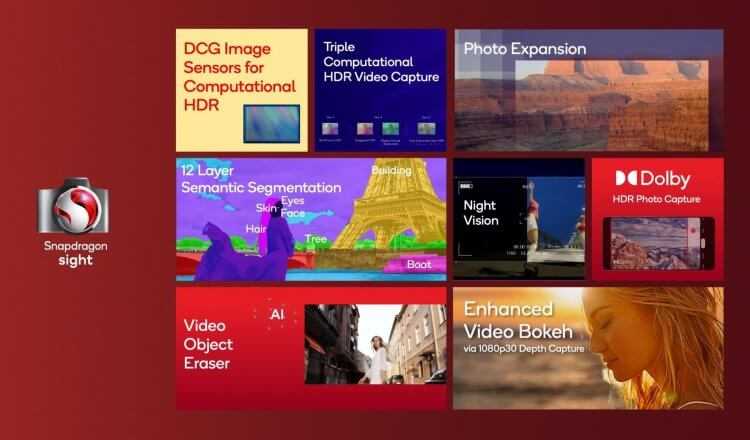
Также смартфоны на Snapdragon 8 Gen 3 получат серьезный апгрейд камеры с прокаченным ночным режимом и возможностью удаления объектов на видео через нейросеть
Работа искусственного интеллекта в Snapdragon 8 Gen 3 обеспечивается новым поколением сопроцессора Hexagon. Он поддерживает генеративные нейросети с 10 миллиардами параметров, что для обычного пользователя ни о чем не говорит, но во всяком случае звучит круто.
Чипсет Snapdragon 8 Gen 3 будет производиться с использованием техпроцесса 4 нм на заводских мощностях TSMC. И это отличная новость, ведь в памяти до сих пор остается опыт сотрудничества Qualcomm и Samsung, доставивший владельцам Android-смартфонов много неприятностей.
Китай потирает руки
Snapdragon 7 Plus Gen 2 выпускается по нормам 4-нанометрового техпроцесса, который и Samsung, и TSMC (контрактные вендоры микросхем) освоили еще осенью 2021 г. С выпуском чипов по этой технологии в 2023 г. никаких проблем не возникает, так что первые устройства на базе Snapdragon 7 Plus Gen 2 ждать себя не заставят.
Как и следовало ожидать, Китай первым заявил о желании видеть Snapdragon 7 Plus Gen 2 в составе своих смартфонов. Раньше всех о разработке такого мобильника заявила компания Redmi – любимая россиянами «дочка» не менее любимой ими компании Xiaomi.
Первым в мире смартфоном на базе нового чипа Qualcomm может стать Redmi Note 12 Turbo. Компания пока что заявила лишь о планах по его выпуску, не раскрыв никаких подробностей о нем и не назвав дату релиза, так что другие вендоры, если поспешат, могут опередить Redmi.
Snapdragon 8 Gen 3 vs Snapdragon 8 Gen 2: AI performance
When compared to the Snapdragon 8 Gen 2, the Snapdragon 8 Gen 3 offers much improved artificial intelligence functionality. This is because it utilises a brand-new AI Engine Hexagon Processor, which is capable of delivering up to 45 TOPS of performance. In comparison, the Snapdragon 8 Gen 2’s Hexagon Processor was only capable of delivering 29 TOPS.
This indicates that the Snapdragon 8 Gen 3 is capable of doing artificial intelligence tasks such as image recognition, natural language processing, and machine learning up to fifty percent quicker than the Snapdragon 8 Gen 2 was able to. Because of this, the Snapdragon 8 Gen 3 is the superior option for users who require an AI-capable device for purposes including work or entertainment.
Заглядываем в будущее телефонов с искусственным интеллектом
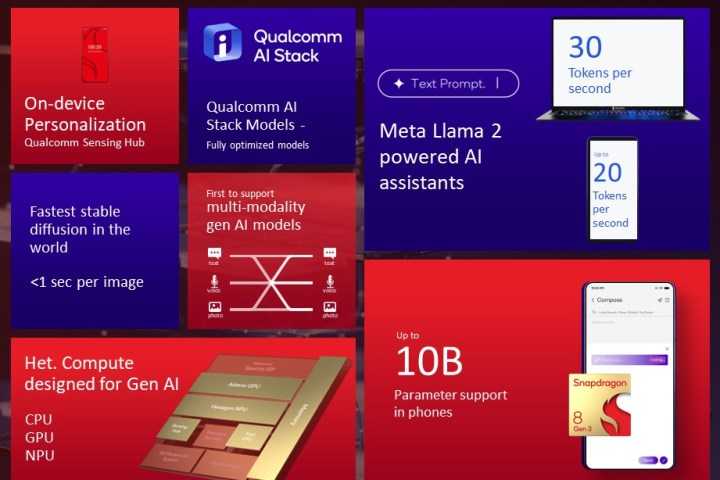 Квалкомм
Квалкомм
Snapdragon 8 Gen 3, идущий по стопам Google Tensor G3 , является признаком появления множества интересных трюков с искусственным интеллектом, особенно тех, которые до сих пор оставались эксклюзивными для телефонов Google Pixel или скрыты за платным доступом в профессиональных приложениях для редактирования настольного уровня. Qualcomm заявляет, что Snapdragon 8 Gen 3 позволит пользователям удалять нежелательные объекты из видео. Кроме того, он использует генеративные приемы искусственного интеллекта Stable Diffusion, позволяя пользователям переключать фон в своих изображениях.
Генеративная заливка AI также является частью пакета, позволяющей пользователям расширять холст своих исходных фотографий, используя AI для добавления большего количества элементов, которых изначально не было в кадре камеры, благодаря прогнозирующей генерации пикселей. Все эти трюки с искусственным интеллектом стали возможными благодаря развертыванию специализированных модулей (которые включают в себя более быстрый на 98% NPU (нейронный процессор), поддержку многомодальных моделей искусственного интеллекта, таких как ChatGPT от OpenAI, и выделенного стека искусственного интеллекта.
Производитель чипов утверждает, что Snapdragon 8 Gen 3 — самый быстрый чип в своем роде, который может обрабатывать запросы Stable Diffusion для преобразования текста в изображение менее чем за секунду. Qualcomm также заявляет, что ее новейший чип может обрабатывать более 20 токенов каждую секунду для генеративных моделей ИИ, таких как Llama 2 от Meta. Когда дело доходит до практической реализации, ИИ-помощник, основанный на этой модели, работает в тандеме со сторонним плагином, таким как SkyScanenr, для Помогите пользователям управлять своими поездками с помощью короткой текстовой/голосовой команды.
Qualcomm Snapdragon 8 Gen 3 vs Snapdragon 8 Gen 2 Specification
| Qualcomm Snapdragon 8 Gen 3 | Qualcomm Snapdragon 8 Gen 2 | Google Tensor G3 | |
|---|---|---|---|
| Process | TSMC 4nm (N4) | TSMC 4nm (N4) | Samsung 4nm |
| CPU | 1x Kryo (ARM Cortex X4-based) Prime core @ 3.3GHz 3x Kryo (ARM Cortex A720-based) Performance cores @ 3.2GHz 2x Kryo (ARM Cortex A720-based) Performance cores @ 3.0GHz 2x Kryo (ARM Cortex A520-based) Efficiency cores @ 2.3GHz |
8-Core 1× Cortex-X3 (3.2 GHz) 4× Cortex-A715 (2.8 GHz) 3× Cortex-A510 (2.0 GHz) |
9-Core 1x Arm Cortex-X3 (2.91GHz) 4x Arm Cortex-A715 (2.37GHz) 4x Arm Cortex-A510 (1.70GHz) |
| GPU | Adreno 750 (claimed 50% faster) |
Adreno 740 | Arm Immortalis-G715 |
| Caches | 12MB L3 cache | 8 MB level 3 cache | Unknown |
| RAM | LPDDR5X @ 4800MHz | LPDDR5X @ 4200MHz | LPDDR5 @ 5500MHz |
| Machine Learning | Hexagon DSP with Hexagon Vector eXtensions, Hexagon Tensor Accelerator, Hexagon Scalar Accelerator, Hexagon Direct Link (Claimed 98% faster AI performance 40% performance per watt improvement) |
Qualcomm Hexagon | Third-gen Tensor Processing Unit |
| Media Decode | H.264 (AVC), H.265 (HEVC), VP8, VP9, 4K HDR10, HLG, HDR10+, Dolby Vision, AV1 | H.264, H.265, VP9, AV1 | H.264, H.265, VP9, AV1 |
| Modem | Snapdragon X75 5G Modem Downlink: 10Gbps Uplink: 3.5Gbps mmWave: 8 carriers, 2×2 MIMO sub-6 GHz: 4×4 MIMO |
4G LTE 5G sub-6Ghz and mmWave |
4G LTE 5G sub-6Ghz and mmWave |
| WiFi | Qualcomm FastConnect 7800; Wi-Fi 7, Wi-Fi 6E, Wi-Fi 6; 2.4/5GHz/6GHz | WiFi 7 | WiFi 7 |
| Bluetooth | Bluetooth: Version 5.4, aptX Voice, aptX Lossless, aptX Adaptive, and LE audio | 5.3 | 5.3 |
The Qualcomm Snapdragon 8 Gen 3 is a significant upgrade from the SD8 Gen2 with a shift in CPU core design. Qualcomm continues to use a single Prime core, which is now based on the ARM Cortex X4.
The main change comes with the other cores. The normal design used to have 4 efficiency cores, similar to the Google Tensor G3, but Qualcomm dropped that down to three with the Snapdragon 8 Gen 2 and then two with the Snapdragon 8 Gen 3.
This then leaves five ARM Cortex A720-based performance cores, with three clocked at 3.2GHz and two at 3.0GHz.
It is worth noting that all the cores are clocked higher than the previous generation and it looks like Qualcomm has really pushed the boat out with trying to maximise performance.
The Google Tensor G3, which was only recently launched, looks quite poor in comparison.
Сколько баллов Snapdragon 8 Gen 3 набирает в AnTuTu
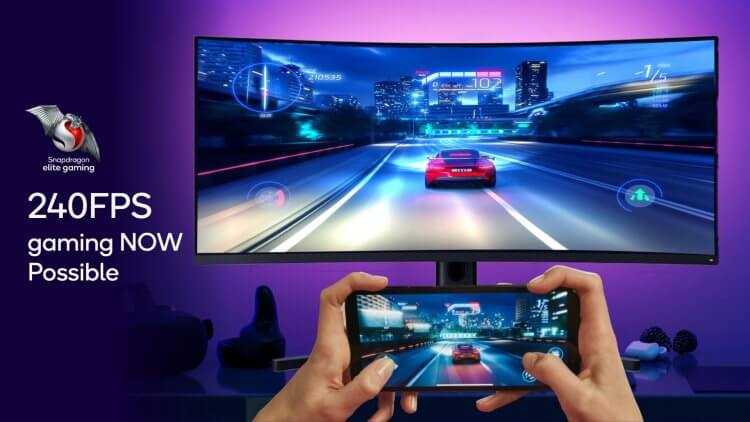
Snapdragon 8 Gen 3 тянет игры в 240 fps
На презентации не показали результат Snapdragon 8 Gen 3 в AnTuTu, ведь точное количество баллов зависит от множества других параметров помимо процессора: оптимизация, система охлаждения, ОЗУ и ПЗУ. Тем не менее, еще за несколько месяцев до анонса нового чипа в сети начали появляться скриншоты тестовых смартфонов, прошедших испытание бенчмарком. Так, в июне сообщалось, что Snapdragon 8 Gen 3 набирает в AnTuTu примерно 1,7 миллиона баллов.
Но уже в октябре китайский информатор Digital Chat Station, на которого ссылается издание Gizmochina, сообщил, что результат Snapdragon 8 Gen 3 в AnTuTu – 2 миллиона баллов. Впрочем, о точных цифрах мы узнаем только после выхода первых смартфонов на новом процессоре Qualcomm.
Snapdragon 8 Gen 3 Could Be a True Successor to 8 Gen 2
Qualcomm did not get the chance to take advantage of the cutting-edge 3nm process of TSMC. Instead, the chipset giant is utilizing the N4P process to mass produce the Snapdragon 8 Gen 3. At the core, the N4P process offers an 11% performance boost over the N5 process and a 6% boost over the regular N4 process (source).
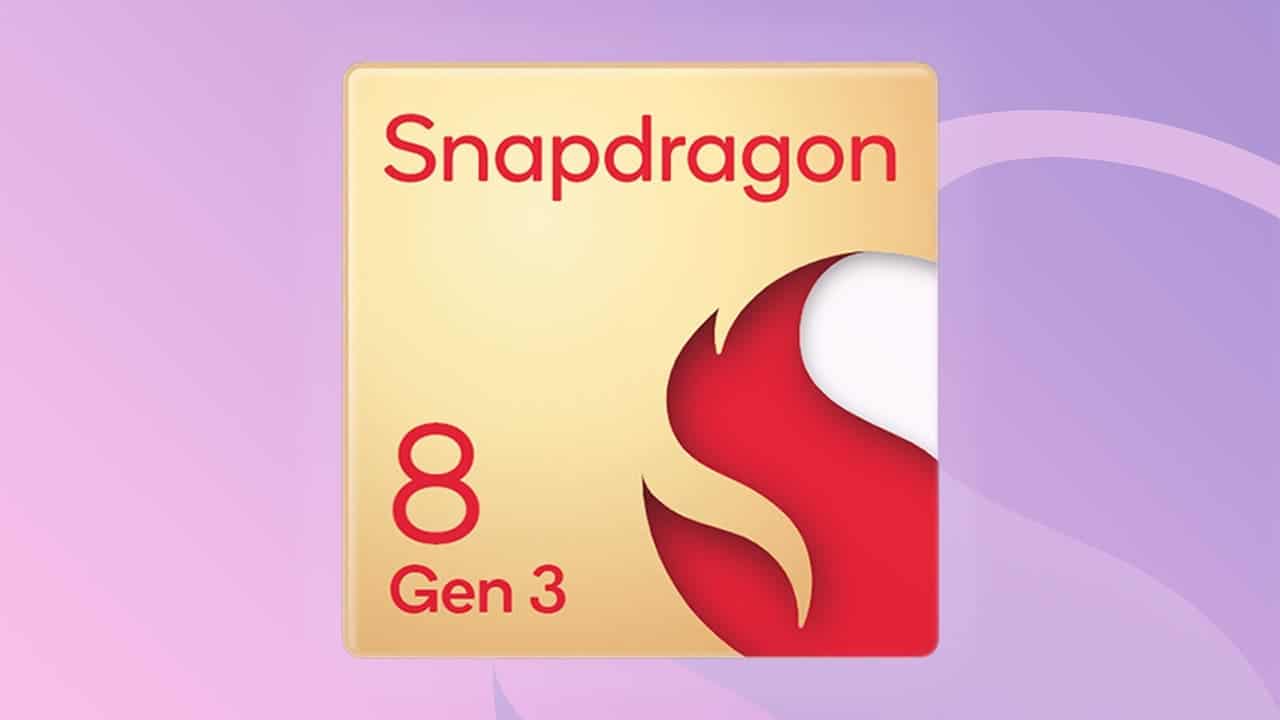
Well, the same exact process has reportedly allowed the 8 Gen 3 to see a major boost in performance. To be exact, the chipset is said to have seen up to a 30% performance boost over the predecessor (source). And a 30% performance difference from a last-gen SoC is a big deal.
That hints that the 3nm process might not have been necessary for 8 Gen 3. And with such a performance jump, the smartphones featuring this chipset will be a powerhouse. There will be reasonable changes in the smoothness and processing quickness while handling resource-intensive tasks.
Snapdragon 8 Gen 3 vs Snapdragon 8 Gen 2: Benchmarks

Hadlee Simons / Android Authority
With the theory out of the way, how does the Snapdragon 8 Gen 3 fare in actual tests? We’re now in a position to answer that question, thanks to Qualcomm’s reference device that showcases the chip at its best. We’ve compiled our testing in a dedicated Snapdragon 8 Gen 3 benchmark article, but here’s a quick look at how it compares to its predecessor.
In GeekBench 6, Qualcomm’s latest chip puts up an impressive showing and lives up to the company’s claimed performance figures. The Snapdragon 8 Gen 3 offers a 40% uplift in multi-core and 18% improvement in single-core vs last year’s Snapdragon 8 Gen 2 in 2023 phones.
The gap is slightly smaller when compared to Qualcomm’s device from last year, which is expected as retail devices don’t always match the reference. Still, it’s an impressive result, with the Snapdragon 8 Gen 3 achieving 31% higher peak performance year-over-year. The new Cortex-X4 and Cortex-A720 cores seem to live up to their promise.
The Snapdragon 8 Gen 3 delivers big CPU and GPU performance improvements.
The winning streak continues on the GPU side. Our 3DMark Wild Life scores give the Snapdragon 8 Gen 3 a 40% lead over last year’s chip, which is above and beyond the claimed 25%. Qualcomm has reportedly alleviated some Vulkan-specific bottlenecks, which should help explain the increased performance in select titles. Likewise, ray tracing can become a target for developers now that the Snapdragon 8 Gen 3 offers 50% better performance.
However, it’s not all good news. The Snapdragon 8 Gen 3 starts out strong but nosedives to half of its peak performance within a few runs of the 3DMark Wildlife Stress Test. Smartphones equipped with last year’s Snapdragon 8 Gen 2 didn’t fall off quite as hard. The latter SoC’s performance simply declined gradually over time. We’ll be sure to test this behavior in gaming and other demanding tasks once we have the first Snapdragon 8 Gen 3 phones in our hands.
Snapdragon 8 Gen 3 vs Snapdragon 8 Gen 2: Phones and bottom line

Ryan Haines / Android Authority
The Snapdragon 8 Gen 2 powers many of the best Android smartphones released in 2023. We’ve almost universally praised it on account of its superb performance and efficiency. The Snapdragon 8 Gen 3 looks like a worthy successor in just about every area. Having said that, we have some lingering questions about sustained performance, given our early test results. After all, this is an area where Android SoCs have struggled in the past.
Qualcomm released the Snapdragon 8 Gen 3 on October 24, 2023. It didn’t take long for the first phone sporting the chipset to hit the market in the form of the Xiaomi 14 series, albeit only in China for now. The SoC is expected to power many high-end smartphones throughout 2024, including big names like Samsung’s Galaxy S24 family.
The last-gen Snapdragon 8 Gen 2 is plenty capable of powering smartphones for years to come.
Simultaneously, however, we don’t expect the Snapdragon 8 Gen 2 to disappear just yet. Qualcomm’s previous-gen SoCs have often made a comeback later in their life cycles in upper mid-range and sub-flagship smartphones. The same should hold true for this last-gen chip too. And considering the amount of performance on offer, it’s undoubtedly a great choice even if it’s no longer the best.
So with that in mind, which SoC should you prioritize for your next smartphone? Given the huge performance uplift, we’d say the Snapdragon 8 Gen 3 does eke out a win vs the Snapdragon 8 Gen 2. However, that equation may change slightly if you can find deep discounts on a smartphone toting the older SoC.
FAQs
Do the Snapdragon 8 Gen 2 and Snapdragon Gen 3 have ray tracing?
Yes, both the 8 Gen 2 and 8 Gen 3 support hardware-based ray tracing. However, the 8 Gen 3 offers a 50% performance boost, according to Qualcomm.
Are Snapdragon 8 Gen 2 and Gen 3 future proof?
Yes. Both offer plenty of performance and cutting-edge features like ray-tracing, AI capabilities, and Wi-Fi 7. Being newer, the Snapdragon 8 Gen 3 is the most future-proof of the two.
Do the Snapdragon 8 Gen 2 and Gen 3 have heating issues?
Neither chip suffers from widespread overheating issues. That said, some smartphone designs are better at dissipating heat than others, meaning some handsets perform at higher levels for longer.
Snapdragon 8 Gen 3 vs Snapdragon 8 Gen 2: AI and other features
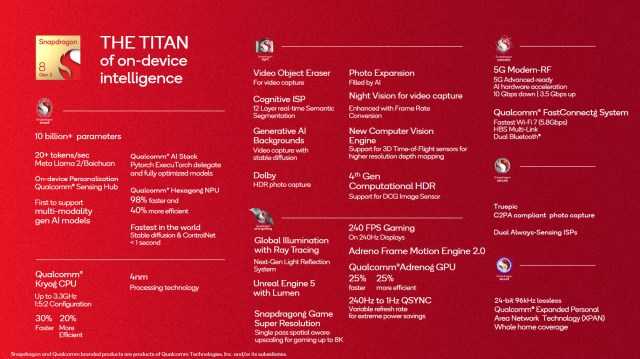
Last year, the Snapdragon 8 Gen 2 introduced some long-awaited features like support for the AV1 video codec, LPDDR5X RAM, UFS 4.0, and Wi-Fi 7. All of these carry over to the Snapdragon 8 Gen 3 too, along with some more improvements. AI has also taken center stage in the tech world and Qualcomm is embracing that trend wholesale with its new flagship SoC. Here’s a quick rundown of the new features coming to the Snapdragon 8 Gen 3:
- According to Qualcomm, the Snapdragon 8 Gen 3’s Hexagon NPU offers nearly double the performance vs the Snapdragon 8 Gen 2. It’s also 40% more efficient and has been designed with generative AI in mind.
- The Snapdragon 8 Gen 3 can run large language models (LLMs) on-device. The company showcased a chatbot demo powered by Meta’s Llama 2 language model, which is an open-source competitor to ChatGPT.
- Beyond text, the Snapdragon 8 Gen 3 also supports multi-modal models that can locally handle text, image, and even speech. For example, the chip can create an AI-generated image using Stable Diffusion within a minute. It can also erase objects in videos, a step beyond Google’s Magic Eraser which only works for still photos.
- Qualcomm’s AI focus extends to the chip’s image processing pipeline too, with the chip’s Night Vision Video capable of shooting usable footage in very dark settings.
- Likewise, a new Photo Expansion feature uses generative AI to extend any image beyond its original boundaries. This is a feature we’ve seen already from the likes of Photoshop Generative Fill, but it’s new on mobile.
- The Snapdragon 8 Gen 3 introduces support for Dolby HDR photo capture with 10-bit color depth.
While these features sound very promising, it’s worth noting that their implementation is entirely up to device makers. Based on past releases, we know that only a small subset of Snapdragon 8 series’ features end up in actual consumer devices every year. If you’re considering an upgrade, we’d recommend checking out a review or two beforehand.
Analysis of the Snapdragon 8 Gen 3’s Reported Performance
GPU Performance
So, according to the new report, most of the upgrades will be noticeable on the GPU side, the Adreno 750. Based on OpenGL performance, the Snapdragon 8 Gen 3 will reportedly see a 30% improvement. That means the next-gen chipset could handle demanding games smoothly.
Gizchina News of the week
Join GizChina on Telegram
In comparison, the Snapdragon 8 Gen 2 gets 60 FPS in the . So, the new chipset could offer around 78 FPS in the same test at 1440p.
Multi-core Performance
Moving on, the report shares that the multi-core performance of the 8 Gen 3 increased by 20%. To compare, the Snapdragon 8 Gen 2 gets 5137 in Geekbench 5 test. That means the new chipset could score around 6164 in the same test. And that score would mean enhanced computing performance.
Single-core Performance
According to the latest report, the Snapdragon 8 Gen 3 sees a 13% performance upgrade in the single-core test. Again, to look back, the Snapdragon 8 Gen 2 scores 1867 in Geekbench 5 single-core benchmark. This hints that the upcoming chipset will score around 2109, which is not a massive difference, but it’s still an upgrade.
That said, the relatively low-performance gain on the single-core test means that Qualcomm might not focus on the Cortex X4 core. Instead, the Snapdragon 8 Gen 3 may indeed see better performance for having more Cortex A720 cores.

Rumored Specs of Snapdragon 8 Gen 3
As mentioned earlier, there are currently two different 8 Gen 3 versions. Details about one have come out recently (source). According to it, the chipset will feature a ‘1+5+2’ configuration with 1x Cortex X4 core, 5x Cortex A720, and 2x Cortex A520.
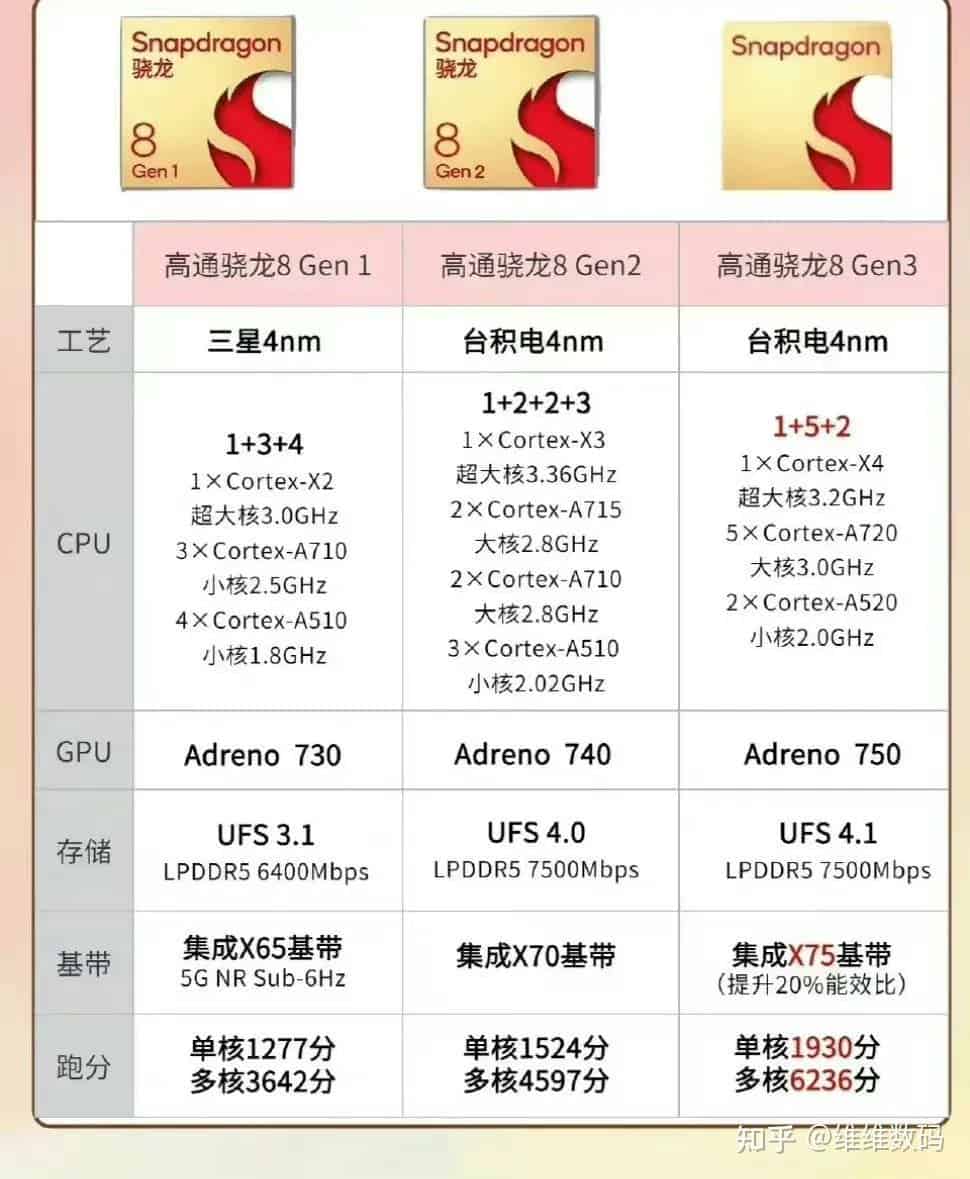
The clock speed of the Cortex X4 core is 3.2 GHz, the A720 cores are 3.0 GHz, and the Cortex A520 cores are at 2.0 GHz. Note that Qualcomm is yet to officially announce the Snapdragon 8 Gen 3. So, take every piece of info about it with a grain of salt.
Disclaimer: We may be compensated by some of the companies whose products we talk about, but our articles and reviews are always our honest opinions. For more details, you can check out our editorial guidelines and learn about how we use affiliate links.
Source/VIA :
Wccftech
Дополнительный ИИ для обработки изображений и многого другого
В прошлые годы Qualcomm довольно активно применяла возможности обработки изображений. Сейчас большого прироста не обещано, но кое-какие улучшения есть и в этой сфере. Для начала давайте рассмотрим, что нового появилось в новейшем цифровом сигнальном процессоре Qualcomm Hexagon DSP, который является основой общесистемного AI Engine Snapdragon 8 Gen 2. Несколько небольших улучшений в сумме дают немало. Во-первых, появилась выделенная система подачи питания. Это означает, что Hexagon DSP может работать без одновременной активации других компонентов, таких как графический процессор. Уникальный энергетический домен станет залогом эффективности. Qualcomm заявляет об улучшении производительности на единицу энергопотребления на 60% по сравнению с прошлым поколением при использовании определённых моделей ИИ.
Добавление INT4 означает, что разработчики могут решать требующие высокой пропускной способности задачи машинного обучения за счёт небольшого уменьшения точности при сжатии более крупной модели. Qualcomm даёт партнёрам инструменты поддержки INT4, так что потребуется обновление существующих приложений. В целом Snapdragon 8 Gen 2 Hexagon DSP имеет производительность в 4,35 раза выше по сравнению с предшественником, в зависимости от модели машинного обучения. Qualcomm в данном случае сравнивает обработку естественного языка mobileBERT. Звучит неплохо, но более значительным изменением может считаться введение Hexagon Direct Link, теснее связывающего ISP с AI Engine. Компания называет это своим «Когнитивным процессором обработки изображений».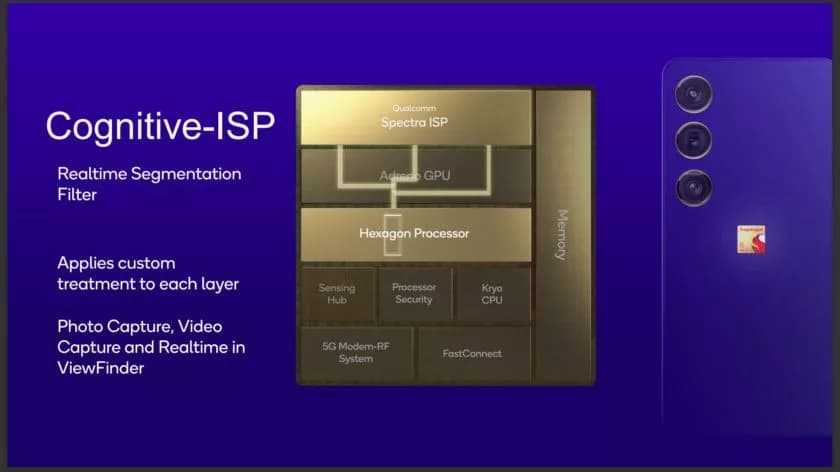 Qualcomm удвоила физическую связь между ISP, Hexagon DSP и графическим процессором Adreno, подняв пропускную способность и сократив задержку. Это позволяет Snapdragon 8 Gen 2 обрабатывать значительно более тяжёлые задачи машинного обучения с данными изображений с сенсора камеры. Например, RAW-данные могут быть переданы непосредственно в DSP/AI Engine для визуализации рабочих нагрузок. Или Qualcomm может использовать линию связи для повышения качества игровых сценариев с низким разрешением, помогая балансировать нагрузку GPU.
Qualcomm удвоила физическую связь между ISP, Hexagon DSP и графическим процессором Adreno, подняв пропускную способность и сократив задержку. Это позволяет Snapdragon 8 Gen 2 обрабатывать значительно более тяжёлые задачи машинного обучения с данными изображений с сенсора камеры. Например, RAW-данные могут быть переданы непосредственно в DSP/AI Engine для визуализации рабочих нагрузок. Или Qualcomm может использовать линию связи для повышения качества игровых сценариев с низким разрешением, помогая балансировать нагрузку GPU.
Это может звучать знакомо. В прошлые годы Qualcomm перемещала различные функции машинного обучения ближе к ISP, в том числе распознавание лиц и сегментацию возможностей видео Боке. На этот раз сегментации стало ещё больше. Прежде более медленная связь означала, что данные изображений часто сначала загружались в основную память, что приводило к высокой задержке, а это приводило к применению сегментации после захвата. Теперь Qualcomm устранила это узкое место, сделав доступнее выполнение сложных рабочих нагрузок, таких как обработка визуализации, на своём AI Engine в режиме реального времени. Осталось только, чтобы партнёры Qualcomm использовали это в своих устройствах. https://www.youtube.com/watch?v=jSzwefx_TXU
Snapdragon 8 Gen 3 vs Snapdragon 8 Gen 2: Benchmarks

Hadlee Simons / Android Authority
With the speculation out of the way in which, how does the Snapdragon 8 Gen 3 fare in precise checks? We’re now ready to reply that query, due to Qualcomm’s reference machine that showcases the chip at its greatest. We’ve compiled our testing in a devoted Snapdragon 8 Gen 3 benchmark article, however right here’s a fast take a look at the way it compares to its predecessor.
In GeekBench 6, Qualcomm’s newest chip places up a formidable displaying and lives as much as the corporate’s claimed efficiency figures. The Snapdragon 8 Gen 3 provides a 40% uplift in multi-core and 18% enchancment in single-core vs final 12 months’s Snapdragon 8 Gen 2 in 2023 telephones.
The hole is barely smaller when in comparison with Qualcomm’s machine from final 12 months, which is anticipated as retail gadgets don’t at all times match the reference. Nonetheless, it’s a formidable outcome, with the Snapdragon 8 Gen 3 attaining 31% increased peak efficiency year-over-year. The brand new Cortex-X4 and Cortex-A720 cores appear to dwell as much as their promise.
The Snapdragon 8 Gen 3 delivers huge CPU and GPU efficiency enhancements.
The profitable streak continues on the GPU aspect. Our 3DMark Wild Life scores give the Snapdragon 8 Gen 3 a 40% lead over final 12 months’s chip, which is above and past the claimed 25%. Qualcomm has reportedly alleviated some Vulkan-specific bottlenecks, which ought to assist clarify the elevated efficiency in choose titles. Likewise, ray tracing can turn into a goal for builders now that the Snapdragon 8 Gen 3 provides 50% higher efficiency.
Nevertheless, it’s not all excellent news. The Snapdragon 8 Gen 3 begins out robust however nosedives to half of its peak efficiency inside a number of runs of the 3DMark Wildlife Stress Take a look at. Smartphones geared up with final 12 months’s Snapdragon 8 Gen 2 didn’t fall off fairly as exhausting. The latter SoC’s efficiency merely declined steadily over time. We’ll remember to check this conduct in gaming and different demanding duties as soon as we now have the primary Snapdragon 8 Gen 3 telephones in our palms.
Snapdragon 8 Gen 3 vs Snapdragon 8 Gen 2: AI and other features

Last year, the Snapdragon 8 Gen 2 introduced some long-awaited features like support for the AV1 video codec, LPDDR5X RAM, UFS 4.0, and Wi-Fi 7. All of these carry over to the Snapdragon 8 Gen 3 too, along with some more improvements. AI has also taken center stage in the tech world and Qualcomm is embracing that trend wholesale with its new flagship SoC. Here’s a quick rundown of the new features coming to the Snapdragon 8 Gen 3:
- According to Qualcomm, the Snapdragon 8 Gen 3’s Hexagon NPU offers nearly double the performance vs the Snapdragon 8 Gen 2. It’s also 40% more efficient and has been designed with generative AI in mind.
- The Snapdragon 8 Gen 3 can run large language models (LLMs) on-device. The company showcased a chatbot demo powered by Meta’s Llama 2 language model, which is an open-source competitor to ChatGPT.
- Beyond text, the Snapdragon 8 Gen 3 also supports multi-modal models that can locally handle text, image, and even speech. For example, the chip can create an AI-generated image using Stable Diffusion within a minute. It can also erase objects in videos, a step beyond Google’s Magic Eraser which only works for still photos.
- Qualcomm’s AI focus extends to the chip’s image processing pipeline too, with the chip’s Night Vision Video capable of shooting usable footage in very dark settings.
- Likewise, a new Photo Expansion feature uses generative AI to extend any image beyond its original boundaries. This is a feature we’ve seen already from the likes of Photoshop Generative Fill, but it’s new on mobile.
- The Snapdragon 8 Gen 3 introduces support for Dolby HDR photo capture with 10-bit color depth.
While these features sound very promising, it’s worth noting that their implementation is entirely up to device makers. Based on past releases, we know that only a small subset of Snapdragon 8 series’ features end up in actual consumer devices every year. If you’re considering an upgrade, we’d recommend checking out a review or two beforehand.




























